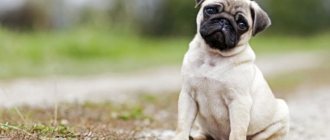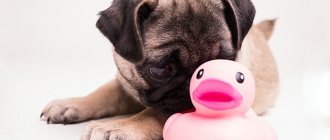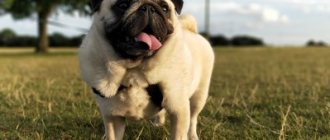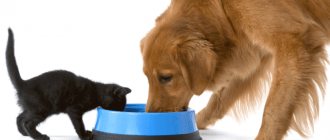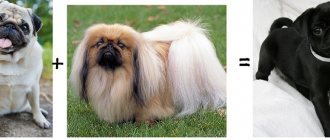How to determine obesity, what is dangerous
A healthy pug is muscular, tightly built, and due to the absence of extra pounds, energetic and active . Excess fat accumulation puts strain on the heart muscle, musculoskeletal system and blood vessels, sharply reducing both the quality of life and its duration.
Experienced breeders know that a pet's weight is a secondary indicator of obesity, as each animal is different. In addition to weight, there is height, body length, bone structure, and the gender of the dog is also important. This is why a normal weight of 6 kg will be for one adult pug, and twice that for another.
Visual signs of the correct weight of a pug are considered: solidity without fat - for a female, a slightly defined waist (without protruding ribs) - for a male.
Important! Monitoring a puppy’s weight is more important in the first months of its life. There is a point of view that in the first six months of life the baby’s weight is equal to his age, that is, a 2-month-old pug should not be heavier than 2 kg.
Despite the unreliability of such an indicator as the dog’s weight, it cannot be ignored if your pet gains 15 kg by the year. Most likely, this will happen smoothly and imperceptibly: one “fine” day you will notice that the pug’s belly has sagged, a strange “duck” gait and wheezing shortness of breath have appeared.
To prevent your four-legged pet from turning into a fat disabled person, weigh him often. This method is suitable for those owners who have visited the veterinarian and found out the optimal weight limits for their dog.
You shouldn’t be moved by looking at an overweight pug - obesity will quickly bring him to the grave. Without a doubt, you will have to lose weight after first establishing why your dog is getting fat.
Puppy weight from 1 to 12 months
The first year of a pug puppy's life is associated with active weight gain.
In the first months of life, pug puppies learn to live independently, without their mother, so they need to be fed - more than 5 or 6 times a day.
Babies may lose weight because they do not cope well with stress. To ensure that puppies do not lag behind in development, they need nutrients and vitamins.
Below is a table of normal age-related changes in weight in pug puppies:
| Puppy age | Weight |
| at birth | 150-250 g |
| 1 month | 1 kg |
| 2 months | 2 kg |
| 3 months | 3 kg |
| 4 months | 4 kg |
| 5 months | 5 kg |
| 6 months | 6 kg |
| 7 months | ~6.3 kg |
| 8 months | ~6.6 kg |
| 9 months | ~7 kg |
| 10 months | ~7.3 kg |
| 11 months | ~7.6 kg |
| 12 months | 8 kg |
A pug should be fed 5 times from 2 to 4 months, 4 times from 4-6 months, and then 3 times a day. The older the dog is, the less often it is fed, bringing meals after 1 year to 1-2 times a day.
IMPORTANT!
Pugs reach their maximum or almost maximum weight from 9 to 12 months. But some of the young puppies can continue to grow until they are one and a half years old. If the dog is in ideal physical condition by this age, this is a bonus in the form of 2 additional years of life.
A healthy pug over one year old weighs from 6 kg to 9 kg with a height at the withers of 28-36 cm. Therefore, if the weight of an adult dog exceeds 9-10 kg, then it must be examined for problems associated with obesity.
Test your dog in these three categories:
- too thin;
- ideal;
- too heavy.
Ideal weight is the key to how long your pet will live. Always try to calculate and measure everything.
But, by the way, calculations are only needed for adults, because puppies are more active and must gain the required weight.
Causes of obesity in pugs
If somatic or mental illnesses are not behind the weight gain, then the blame falls entirely on the owner who overfed his pet.
The pug has no willpower, but has an excellent appetite and a pitiful look, thanks to which the pretender will always get the coveted piece in excess of the norm. A couple of such snacks a day and in front of you is a bag of lard dragging your feet with difficulty.
Here is a case when human pity is inappropriate: be tough and do not feed the pug from your table . If monthly weighing shows that the dog has become significantly heavier, look for the cause in the diet.
But an unbalanced diet is not always the culprit of obesity: the age of the animal and its reduced activity contribute to weight gain. Your dog may become plump by leaps and bounds due to:
- hormonal abnormalities;
- chronic stress;
- endocrinological disorders.
Before putting your dog on a diet, take him to the clinic for tests. The doctor will determine why the dog is gaining weight and tell you whether he needs a special diet. Return to content
Prohibited Products
It is imperative to completely exclude a number of foods that are harmful to the dog’s body from the pug’s diet:
- pasta;
- wheat and semolina porridge;
- potatoes in any form;
- legumes;
- corn and soybeans;
- chocolate and candies;
- flour products;
- sour cream and ice cream;
- smoked meats;
- mushrooms;
- any citrus fruits;
- grapes and raisins;
- pickles and marinades;
- seasonings;
- fatty meats;
- sausages, sausages and sausages;
- fried foods;
- tubular and sharp bones.
It is strictly forbidden to use any low-grade and cheap dry or wet food in your pug’s diet, which simply contains a huge amount of meat substitutes and offal, as well as all kinds of dyes and flavor enhancers.
Diet for pugs with obesity
If the examination reveals that the dog is sick, changes in the composition of the food should be controlled by a veterinarian. In this case, reducing the portion is not an option. The portion will have to be reduced if the weight gain is due to overfeeding the dog: a dog sitting on a “drying diet” is transferred to products labeled “diet food.”
The owner himself chooses what is best for the little fat one: cut the portion or reduce the number of feedings. In the most advanced cases, you will have to combine both methods. Need I say that during the breaks between meals, any snacks and especially pieces from the host’s table are excluded?
The portion is reduced gradually, first reducing the amount of food eaten per day by 10% . Some dog breeders switch their pets to fractional feeding, not reducing, but increasing the number of meals. This advice is not suitable for all dogs, and it will take practice to find out if it is reasonable (with the help of daily weighing and a veterinarian).
Usually the portion is reduced until the pug stops gaining weight.
Important! Dogs with a fast metabolism rarely need to adjust their diet: they can eat a full bowl of food twice a day without losing weight. For animals with a slow metabolism, older pugs or small bitches, half a cup will be too much.
Natural products will also help to get the glutton in shape, of course, in doses prescribed by the doctor:
- lean poultry meat;
- low fat fermented milk products;
- white fish;
- pearl barley;
- fruits vegetables.
To compensate for the lack of micro- and macroelements, add vitamin supplements and bone meal to the “natural” food.
An aging, obese pug is fed 1 or 2 times a day, protecting its digestive system from excessive stress that is inevitable with repeated feeding. In the morning he receives cottage cheese, lean porridge, vegetables and an egg (of your choice), and in the evening - some fish or poultry meat. Return to content
Physical activity
Pugs are notoriously lazy and lazy, and when they get fat, they are doubly so. But you won’t be able to lose kilos that are harmful to your health without systematic exercise. You must remember that your beloved “barrel” on legs is already experiencing constant stress on the joints and heart, which is why physical activity at first should be extremely gentle.
You need to start by adding more time to daily exercise: the weight will begin to go away as soon as the dog begins to expend more calories than it receives from food. The supplier of the necessary energy will be its fat reserves. Do not forget about the smooth rise of physical activity, increasing walking by 1.5-2 times in the first days.
Important! Often the pug refuses to walk due to the pain experienced when moving. In this case, both the appropriateness of the expected loads and methods of treating the dog’s diseased joints are discussed with the veterinarian.
But even with healthy joints, do not force the dog to run, unless you want to give him a heart attack. You can start running after 2-3 months of long walks, when your heart is sufficiently trained.
A leisurely run will be followed by a game of fetch, and then swimming, speed running and hurdles. Based on the well-being and appearance of your pet, you can go with him to conquer the obstacle course.
If you have the finances, pay for the services of a specialist who will develop a diet menu and create a training schedule for you. As a rule, such cooperation lasts at least a year: the doctor monitors the animal’s condition, changes (if necessary) the training plan and diet.
A pug that has returned to optimal physical shape will delight you with cheerful jumps and nimble running.
Table of fatness depending on age
| Dog age | Dog weight, kg | |
| Male | Bitch | |
| 1 month | 0,9-1,1 | 0,9-1,1 |
| 2 months | 1,9-2,1 | 1,9-2,1 |
| 3 months | 2,9-3,1 | 2,9-3,1 |
| 4 months | 3,9-4,1 | 3,9-4,1 |
| 5 months | 4,9-5,1 | 4,9-5,1 |
| 6 months | 5,8-6,2 | 5,8-6,2 |
| 7 months | 6,8-7,2 | 6,3-6,8 |
| 8 months | 7,8-8,2 | 6,8-7,0 |
| 9 months | 8,8-9,2 | 6,9-7,3 |
| 10 months | 9,9-10,1 | 7,3-7,6 |
| 11 months | 10,9-11,2 | 7,6-8,0 |
| 12 months | 11,9-12,1 | 8,0-9,0 |
The pug is overweight. What to do?
Obesity in pugs is one of the most discussed topics on forums for fans of this breed. Many owners incorrectly prepare their pet's diet, which is why a fat pug appears. Today we will look at how to lose weight for a pug. So, most importantly, the pug does not need to be overfed. Most dogs of this breed love to sleep and eat something, and not all owners give them the proper amount of physical activity.
One of the main mistakes of owners is that they feed their dog from the table, which in no case should be done. It’s hard to refuse cute dog eyes, but pugs often can’t control themselves when they see food, so think a hundred times before giving your pet another tasty treat and don’t give in to your feelings.
Why is excess weight harmful?
Some people think that a fat pug is not a problem and it has no effect on his health, but this is not true at all. “Excess weight is very harmful for pugs, because they are initially quite dense and muscular. Fat can cause serious illness and even death to a dog.”
Here is a list of only the most common diseases:
- ligament ruptures - respiratory ailments - joint diseases - lack of endurance - diabetes mellitus - obesity of internal organs - disruption of the respiratory system
When is it time to lose weight?
Now let's look at when a pug needs to start losing weight.
First, it is very important to monitor your pet's weight. Owners who truly love their pets care about their health, and monthly weighing is a very important part of this care.
If you notice that your dog has gained weight, consider changing his diet. However, it is important to remember that before changing your dog's menu, you need to consult with your veterinarian. A good specialist will select the food that will quickly tone up your pet.
Secondly, obesity can be noticed by sight, so examine your dog regularly. If you look at the dog from above, you should see the waist (namely, the narrowed area of the body in front of the hind legs).
If it is not there, this is a sign that the pug has gained weight. The second way is to palpate the ribs. Run your hand along your dog's side: if everything is normal, the rib is not visible externally, but it can be easily felt.
If it doesn't, it's a sign that it's time for your Pug to lose weight. Another good way is this: examine your pet from the sides. You should see a smooth transition from the chest to the stomach. If the back is too wide or the pet's belly sags, this is a sign of obesity.
Diet for obesity
When planning a diet, it is very important to consult a veterinarian, because fat pugs are often found to have various diseases. However, if you are 100% sure that your pug is absolutely healthy, you can create a diet yourself.
The dog’s diet should consist of: - poultry meat - vegetables and fruits - cereals - white fish - fermented milk products
Gradually reduce your dog's food intake. Give her less meat and fish, replacing them with vitamins. This will significantly improve the dog’s health, as it compensates for the lack of micro and macroelements in its body. Feed the dog in small portions 4 times a day, but if the dog is elderly, it is better to do it once, since the pug’s digestive system is already weakened, there is no need to subject it to additional stress.
If you have previously fed your dog dry food, you should not immediately switch it to natural feeding - this will expose its body to stress. The transition to natural language should be done slowly and gradually.
Here is a list of the most common diet foods: Royal Canin Gastro Intestinal Low Fat Hill's Prescription Diet c/d Urinary Care dog Brit Premium by Nature Light for overweight adult dogs
Never feed your pets cheap food - they often contain foods prohibited for dogs and do not satisfy all the needs of the animal’s body.
Features of feeding
The most balanced diets include wet and dry foods of the holistic and super-premium classes. Veterinarians and experienced pug owners recommend using the following brands of industrial food to feed pets of this breed:
- canned Barking Heads, consisting of 60-70% meat or fish, vegetables, seaweed, basil, brown rice, vitamins and minerals;
- Velcando dry and wet food with a balanced composition and hypoallergenic natural ingredients;
- food for pugs with chicken intolerance Hills Ideal Balance;
- dry high-quality food with hypoallergenic components and reduced calorie content under the Eukanuba brand;
- food under the Almo Nature brand, characterized by a wide variety of options, different in composition and taste, with different consistencies and in convenient packaging.
Bozita super premium dry and wet food is less in demand, which is due to the complete absence of vegetable crops in such a diet, as well as the presence of chicken and rice - quite strong allergens for pugs.
- lean meat – 33%;
- vegetables – 33%;
- cereal crops – 33%;
- vegetable oil and vitamin supplements – 1%.
This porridge should be fed only fresh and warm. Remaining portions must be disposed of. Meat products must be cut into fairly small cubes, then boiled or doused with boiling water. Beef by-products, such as tripe, liver, heart and lung, are an excellent addition to meat, but cannot be a complete replacement.
Vegetable and fruit products can be given raw, as well as stewed and boiled. The animal must be accustomed to such products from an early age, since it is very difficult for an adult pet to get used to any new tastes. The best option is to prepare the broth using lean meats, adding a spoonful of olive or sunflower oil.
- up to two months - food is given six times a day;
- from two to four months - food is given four times a day;
- from four months to six months - food is given three times a day;
- from six months to ten months - food is given twice a day.
Starting from the age of one year, it is recommended to feed your pet twice a day, but if necessary, it is possible to transfer the pug to one meal a day. The first complementary foods are introduced to the puppy starting at the age of one or one and a half months. For this purpose, you can use low-fat kefir or yogurt, as well as cottage cheese.
Then the diet is gradually supplemented with lightly stewed and salted vegetables, well-cooked rice or buckwheat porridge. If your pet is actively growing and gaining weight well, then the diet is optimal. If necessary, vitamin and mineral supplements are added to food.
Starting from about three months of age, the main emphasis in the diet should be on meat products and low-fat boiled sea fish without bones. If the owner does not have the opportunity to feed the puppy natural food, then it is necessary to select industrially produced dry or wet food that is optimal in composition and age-appropriate. It is important to remember that the transition from one type of nutrition to another must be smooth and gradual.
Canned dog food
First of all, when feeding natural products, the dog should be given chicken, rabbit, veal and lamb. It is advisable to give meat raw, as it retains more vitamins and is better digested. Vegetables are not always a source of vitamins.
Liver contains large amounts of vitamin A; this product should be given to animals with caution.
The fish is given boiled; it is rich in calcium and phosphorus.
The advantage of industrial feed is that it contains a lot of protein, little fat and calories.
So which is better? Perhaps everyone will choose the best option for their pet on their own or with the help of a specialist.
It is quite expensive to choose a menu for a pug correctly and follow it, so ready-made food solves such issues.
Expert opinion
Tolkachev Andrey Mikhailovich
veterinarian
Nutritionists do not recommend combining dry food with homemade food. If you choose homemade food for your pet, then forget forever that the dog eats the same thing as you. Do not give any table scraps or sweets under any circumstances. Feeding your pug natural food creates the need for nutritional supplements and vitamins. Industrial food guarantees good hygiene and eliminates the risk of poisoning the dog. The main disadvantage is the synthetic additives and flavors. Plus – balanced food with the right set of carbohydrates, fats, vitamins, micro- and macroelements. Some foods use probiotics to help absorb nutrients and good intestinal microflora. Industrial feed is easy to use during trips and travels.
If the animal is predisposed to diseases of the gastrointestinal tract, add fermented milk products to the dry food twice a week.
It’s important to choose food wisely—it’s best to consult a veterinarian in this matter. In some cases, animals fed exclusively dry food developed liver, kidney and pancreas diseases.
The advantages of industrial feeds are nutritional balance. They contain all the useful vitamins and amino acids.
IMPORTANT!
If you feed your pug dry food, be sure to provide plenty of water. It is also necessary to follow the recommended standards and measuring cups.
If you give your dog artificial food, you should not:
- combine feed from different manufacturers;
- give your dog vitamins and other supplements;
- pour boiling water over food;
- alternate food and natural food;
- Industrial food must be selected individually - some pets may have allergies. It is advisable to choose hypoallergenic food from premium brands Hill's, Acana, Eukanuba, etc. If you decide to switch to another food, it will take a week for the gastrointestinal tract to adapt to the new food. If the puppy refuses to eat dry food, you need to add a little warm water to it.
Dry food labeled grain-free is dietary and low-calorie. It is advisable to give it to dogs with obesity.
Canned porridge with meat is a type of wet food that does not require the addition of dry food. They also contain all the ingredients necessary for the development of a pet.
If you feed your dog only wet food, your little friend will eat his food quickly without chewing - this is harmful to his gastrointestinal tract. Therefore, alternate between dry and wet food.
According to reviews, the following are the most popular among dry food:
- Eukanuba;
- Hills;
- Royal Canin;
- Akana;
- FestMate;
- Canide.
In situations where the bitch is not able to feed the puppy, the owner takes care of feeding the puppies. Powdered milk is sold to feed puppies; if this is not available, it is replaced with baby formula.
NOTE!
Cow and goat milk are contraindicated for puppies, as they can cause an allergic reaction and digestive upset.
In the first month, puppies are given:
- curdled milk;
- yogurt without sugar;
- cottage cheese;
- some minced meat;
- vegetable puree.
To ensure your baby eats well, you can add a little honey to the cottage cheese.
At 1.5 months, add quite a bit of fresh raw liver, preferably chicken, to the above.
At 2 months, it is necessary to add white fish (cod or pollock) minced and boiled to the food.
At 3 months, the puppy's teeth begin to change, so you can start giving him cartilage or soft bones.
At 4 months, the diet contains all the foods that can be fed to an adult pug.
After the fourth week after birth, puppies need to be fed 4 times a day.
Menu for dogs from 1 to 3 months:
- 1st meal - porridge, vegetable puree, some fruit.
- 2nd and 3rd meals - the menu contains meat, necks, legs and wings of poultry, which are beaten with a hammer.
From 3 to 7 months, puppies are fed the same, but the portions are slightly increased, because babies grow quickly and move a lot.
At 6 and 7 months, pugs switch to three meals a day. After 7 months, puppies are transferred to two meals a day.
There should be a bowl of fresh water in the place where the pug feeds.
Proportionally, 30-70% of the diet is meat:
- mutton;
- rabbit meat;
- veal;
- bird.
25-30% of an adult dog’s menu is cereals, 20% fermented milk products. 15-20% - vegetables.
Serving 20 g per kilogram of weight.
You can give your pug cabbage, carrots, pumpkin, cucumbers, bell peppers, herbs and garlic (you can give a clove 2 times a week). The fish is served boiled, after removing the bones.
IMPORTANT!
After a year, you need to feed the dog 2 times a day. The older the animal, the less it should be fed, bringing food intake to once a day to avoid pet obesity.
Why you shouldn't give your dog treats from the table
Many pugs beg their owners for food when they eat, and compassionate dog owners throw their pet either a sausage, a piece of cheese, bread, or something else.
Let's figure out why this shouldn't be done.
Firstly, many foods from our table cannot, in principle, be given to a dog. Our food is so different from the food that a dog needs that it can not only cause various diseases, including obesity, but can also kill your pet. Secondly, you disrupt the pug’s diet, which again leads to obesity.
Dry food: which is better?
If you decide that your little pet will eat food, then choose only a high-quality product. To prevent the dog from suffering from excess weight in the future, and pug owners often encounter this, the food should:
- have low calorie content;
- be as nutritious as possible;
- contain animal proteins.
The type of food should be selected according to age:
- If your baby is between 6 and 12 months old, junior food is suitable for him.
- A one-year-old pug and older should be given standard food.
Among the best foods are the following:
- Hills . American and European super premium product for feeding pets. The standard food contains vitamins, meat (and meat flour), wheat, corn, potatoes and a number of other products useful for pugs.
- Akana .
This product is also among the best for animals, and even more so for pugs, since they are holistic, and some types are suitable for treating obesity. Akan food is considered premium, and in Europe and America this food is recognized as the best. Akana food contains many vitamins, and more than 60% is meat. The food from this manufacturer does not contain flavorings or by-products. This nutritional product for dogs may contain berries, potatoes, medicinal herbs, oats and other beneficial substances for four-legged animals. And thanks to antioxidants, fatty acids and other beneficial components, pugs eating this food do not gain excess weight. - Canidae . Food from American manufacturers, which is considered super premium. Food for dogs contains everything that this breed needs for normal nutrition, for example, vegetables, meat and meat flour, potatoes, minerals, vitamins, etc. If your pet is prone to allergic reactions or is overweight, It is recommended to pay attention to the food from the Grain Free line.
Physical training
Just like a human, exercise is very important for an overweight pug, but you should be careful. Too much stress can lead to disastrous consequences, such as cardiac arrest. Gradually increase the duration of walks; for starters, 1.5 times is enough.
The most popular exercise for dogs is fetch the ball. It will keep your pet entertained and moving. After some time, you can begin to overcome obstacles, but you should not overdo it.
It is best to have a professional trainer create a training schedule. He will select the appropriate exercises and quickly get your dog in good shape.
Our article has now come to an end. Thank you all so much for reading. Remember that your pug's health depends primarily on you. Keep an eye on it so that your pet lives happily ever after. Was the material helpful? How much does your pug weigh? Write in the comments.
source
Pug weight as an indicator of its health
Most pugs are big fans of chewing something and sleeping. Moreover, not every owner will be able to resist throwing some treats from their table to their pet. Disorderly eating leads to the fact that instead of a small friendly dog, a solid, fat pug appears.
Excess weight is highly undesirable for pugs because... They themselves are quite muscular and dense. Excess weight negatively affects the dog's circulatory system and heart, and ultimately leads to illness or even premature death of the animal. You should not give free rein to your feelings and overfeed your dog.
How to lose weight for a dog
Even if your pug is using all his charm skills on you, don't let him overeat. After he has eaten his portion, put the bowl away until the next meal. It is very important not to leave your dog without water. But it is not recommended to give tap water as it contains too many bacteria. Provide your pug with clean, filtered water. Don't forget that your dog's food should not be too cold or too hot.
Maintain balance. Do not make soup or stew out of food for pugs: their stomach is only suitable for solid food, as it is too small in size.
In addition, the dog may develop a saggy belly, which will subsequently lead to back problems. Also, liquid and porridge-like food does not contribute to full saturation of the body.
It is not allowed to add salt to pug meat. It must be ingested raw; the pug’s stomach will not digest cooked meat. Vegetables can be salted, but not to the same extent as is done for humans. Occasionally it is allowed to please the dog with salted fish. It is recommended to include milk in your pug's diet. It helps get rid of heartburn, which so often torments representatives of this breed. Feeding a pug puppy.
Nutrition from 1 to 3 months During this period, the dog is developing very actively, the dog’s body must receive all the necessary microelements and vitamins. An approximate diet at this age: the first feeding is finely chopped raw veal or beef.
Causes of excess weight
Weight gain in pugs occurs, just like in humans, gradually and almost imperceptibly.
Owners who truly care about the health of their dogs keep track of their pets' weight. If, during monthly weighing, it turns out that the pug is becoming more massive, it is worth reconsidering its diet.
Before changing your dog's menu or feeding schedule, you will need to consult with your veterinarian.
In most cases, a fat dog is the result of excess and unbalanced nutrition. However, the reason for excess weight may not lie in the pet’s menu.
It is necessary to take into account the age of the dog and its activity. To avoid future problems, it is worth getting tested because Hormonal imbalance, stress or thyroid disease can lead to obesity in a dog. A diet can harm a dog if it is sick with something.
Diet for overweight
If the examination reveals a hidden disease, then the pug should lose weight under the supervision of a veterinarian. A change of menu is necessary if the dog suffers from a permanent illness. If a pug has gained excess weight due to the excessive kindness of its owner, then you can help it yourself.
A diet made up of natural products will help your pug lose weight: poultry meat, white fish, fruits, dairy products, cereals, vegetables.
Of course, the dog should not get any treats from the table, neither sausages nor flour. Gradually, the pug's portion size needs to be reduced.
To do this, the total amount of food is reduced by 10%, and the dog should eat four times a day.
If you feed your pug twice a day, offering him huge, generous portions, then the fight against obesity will drag on for many months. Having reduced meat and fish in the dog’s diet, you need to add bone meal or vitamins to the food, this will compensate for the lack of micro and macroelements in the dog’s body.
If obesity is caused by the advanced age of the pug, then it is better to feed it once a day. Because with repeated feeding, the dog’s digestive system will be subject to excessive stress.
Fish or meat is given to an aging dog in the evening, two hours before the last walk, or two hours after it. The morning diet is limited to lean porridges, vegetables, cottage cheese, eggs.
When purchasing ready-made dog food, keep in mind that there are two categories. Economy class food contains a minimum of meat, but they contain an increased amount of grains, bone meal, and vegetables.
The energy value of such a product tends to zero. Dietary food of proper quality contains the required amount of fish or meat, and it is prepared according to a special recipe. In order for the dog to better absorb nutrients, proteins and carbohydrates are initially slightly processed.
Diet recommendations for puppies
Up to one and a half months, the puppies' diet should consist of mother's milk. Starting from 1 month, you need to decide on the type of food and start feeding the puppies. It is recommended to feed puppies with ready-made factory food or natural products.
Canned factory food is well suited for feeding puppies ; they are the most nutritious. The disadvantage of such feeding is the price of such canned food . When choosing factory-made dry and canned food, you need to pay attention to its composition and the age of the puppy.
It should be noted that when feeding canned food, it is not recommended to add natural products to the diet. When combining two types of food, the puppy's metabolism may be disrupted, which will lead to obesity or dystrophy. Plant-based foods may be an exception.
If the owner does not have the financial ability to feed the puppy high-quality canned food, the best option would be to feed him natural products.
The diet of a pug puppy when feeding it with natural products:
- Fermented milk products.
- Cottage cheese.
- Vegetables, raw or stewed.
- Buckwheat or rice porridge with added butter.
- Egg yolk.
- Fruit puree.
- Fresh fruits in crushed form, except grapes.
- Any raw lean meat except pork.
Food should not be hot or very liquid. Liquid cereals, purees and soups are the main cause of deformation of skeletal bones and sagging of the peritoneum. Only with a balanced diet and active physical activity can obesity be eliminated in a pug puppy.
Exercise for a pug
Regular physical activity will help a pug, like an overweight person, lose weight.
Although, extreme caution must be exercised here too. Obesity in a pug means increased stress on its heart and joints. Therefore, you should not force your dog to run around the house, this can lead to dire consequences, even death. An important element for health will be gradual physical activity. Initially, you just need to increase your walking by 1.5 – 2 times.
After two to three months, the pug’s heart gets used to this rhythm and you can move on to active games. The first exercise will be a slow, thoughtful run, then “fetch the ball.”
The final step in restoring the dog’s shape will be overcoming barriers, speed running, and you can even go on an obstacle course.
Ideally, it is best to resort to the services of a veterinarian who will draw up a dog’s menu and determine the schedule and intensity of training. A competent specialist will monitor the condition of the pug, adjusting diet and training if necessary.
Of course, services of this kind are not cheap, but the health of your four-legged companion is priceless. This type of cooperation lasts about a year, during which the veterinarian records all changes in the dog’s health.


